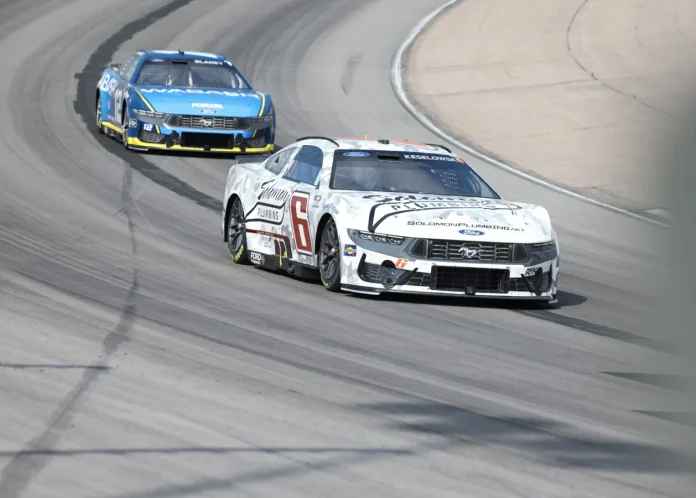Brad Keselowski on NASCAR driver culture has become a focal point this season, as the RFK Racing co-owner and Cup Series driver voices serious concerns about changes in accountability and aggression among today’s competitors. In light of recent on-track incidents, Keselowski argues that a new mindset is taking root, where reckless wrecks and diminished responsibility are becoming standard.
Keselowski’s perspective was ignited following events during the 2024 Hollywood Casino 400 at Kansas Speedway, a playoff event where mid-pack aggression was on full display. An onboard video from Keselowski’s own car, circulating widely thanks to NASCAR fans, captured the tense reality of Cup Series racing with team radio providing immediate context.
The conversation escalated after Keselowski shared the video and commented:
“Single biggest change I’ve seen in the cup series drivers over last 10 years – Complete willingness to semi-intentionally wreck each other running 15th or worse. I see it almost every week and none worse than this week in Iowa. Not sure what to make of it.”
This blunt observation came soon after the Iowa Corn 350 at Iowa Speedway, which was marred by 12 caution periods and highly visible contact between several drivers. One notable episode on Lap 229 saw Carson Hocevar make contact with Zane Smith, pushing the No. 38 Ford into the SAFER barrier. Although Smith was running 23rd and out of contention, the incident was emblematic of what Keselowski criticizes—a repeated pattern of low-stakes, high-risk moves from drivers with little on the line, causing massive consequences for others.
In the aftermath, part-time competitor Josh Bilicki weighed in, sparking a technical discussion:
“In your opinion, how much of this is caused by aero blocking and how hard it is to pass with the current car? Or is it just the new gen of racers?”
“It’s not the car,” he replied, pointing to driver behavior.
Keselowski clarified that while accidents at the front matter, his frustration stems largely from the intentional or careless collisions in the midfield, which he perceives as more calculated and senseless than ever before.
Accountability and Team Ownership: A Lost Standard in Cup Racing
Much of Keselowski’s criticism centers on shifting team dynamics and car culture. Since the introduction of the Next Gen car in 2022, NASCAR put an emphasis on parity and equal machinery, aiming to improve the competitive landscape. However, according to Keselowski, this change has worsened aerodynamic issues and made passing more difficult, especially due to “aero-blocking” tactics that prevent trailing cars from mounting overtakes.
With more aero-sensitive vehicles, positioning—especially clean air at the front—has become decisive. Leading racers now control airflow and can stifle the progress of faster competitors with small but effective maneuvers. At challenging circuits like Dover, even faster cars struggle to pass because being trapped in “dirty air” behind the leader makes their cars unstable and limits aggressive attempts to move forward.
Yet for Keselowski, the technical side is only part of the story. A key focus for him remains the fading accountability between teams and drivers in the Cup Series. When questioned whether difficulty in passing or a lack of respect for competitors was the more pressing issue, he turned his attention toward team owners and their reduced hands-on involvement:
“Car owners used to be much more present and accountability driven. They would surely fire you for one of two reasons – Wrecking and Not running well. If you did both as a driver, no chance of making it. This made all the drivers not want to wreck when they weren’t running well.”
In earlier years, recklessness on track could cost a driver their career, especially for those running outside the top positions. Drivers self-policed, and car owners strictly enforced discipline. Now, Cup teams operate with smaller leadership groups, and many owners interact less directly with their drivers. Combined with a system where cars are easier and more economical to replace, aggressiveness increases while the threat of terminal consequences recedes.
The Impact of Car Design and Culture on Racing Integrity
Racing personalities such as Kyle Busch and Denny Hamlin have noted how the prevalent “composite body” racecars foster disposable attitudes—not just toward the machinery, but toward racing conduct itself. With today’s cars being repairable and interchangeable, Keselowski observes a growing willingness among drivers to race with desperation or impatience, especially as they try to prove themselves in the Cup Series.
This shift has translated into more frequent wrecks involving drivers who, in many cases, have little to gain from rough tactics due to their positions outside the front-running pack. According to Keselowski, what has been lost is not just respect, but a sense of personal and collective accountability that made the Cup Series distinct in earlier decades. He believes this is eroding the culture from within.
As the season progresses and on-track incidents continue to attract attention, Keselowski’s critique is fueling a broader conversation about how the Cup Series can maintain its credibility. With incidents like those at Iowa Speedway and Kansas Speedway serving as recent, high-profile examples, there is mounting pressure on NASCAR, team owners, and drivers themselves to confront the issues of accountability and aggressive tactics head-on.
Whether this dialogue leads to fundamental change remains to be seen, but with respected figures like Brad Keselowski, Zane Smith, Carson Hocevar, Kyle Busch, Denny Hamlin, and others speaking out—often with frustration and urgency—it is clear that the debate around driver culture and ownership standards will not fade quietly away.


